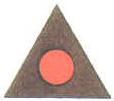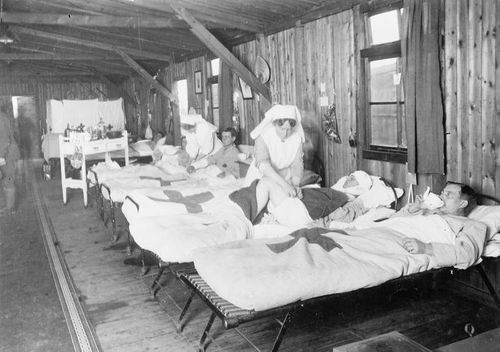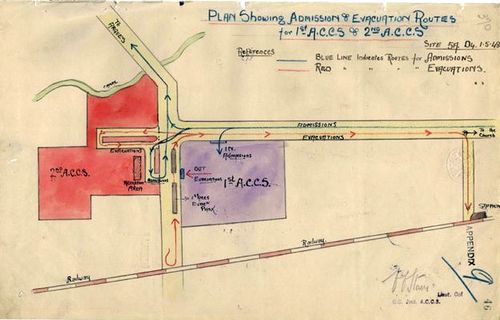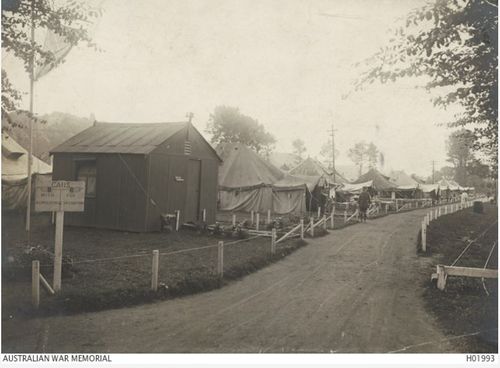Difference between revisions of "2nd Australian Casualty Clearing Station"
From Our Contribution
(→Soldier Patients by date admitted) |
(→Soldier Patients by date admitted) |
||
| Line 99: | Line 99: | ||
*[[Harold Hopgood Surman]] 26 Sep 1917 | *[[Harold Hopgood Surman]] 26 Sep 1917 | ||
*[[Albert Edgar Bishop]] 2 Nov 1917 | *[[Albert Edgar Bishop]] 2 Nov 1917 | ||
| − | *[[Thomas Allan O'Dea]] | + | *[[Thomas Allan O'Dea]] 22 Nov 1917 |
Revision as of 23:34, 11 August 2018
General Information
Nos. 1 and 2 A.C.C.S. arrived in France with the A.I.F. and were at once established behind the force in the British Second Army with No 2 opening for patients on 29 Jul 1916 at Trois Arbres, near Bailleul, about 6,500 metres from the front lines. Early on work was steady but not overly heavy until May and June 1917 (20 July 1916. In twenty-six hours, 2,357 patients had been evacuated through the 2nd Australian Casualty Clearing Station at the railhead at Trois Arbres. By July 21st 3,984 had been cleared.) In May and June 1917 workload was heavy enough to require additional staff to be allocated from the 2nd Australian General Hospital increasing the Nursing Staff to 14. During the day 3 operating tables were on the go, and usually 2 at night. During July and August almost 2,000 operations were performed in this unit alone. They remained at this site until 15 Mar 1918.
In July 1917 the unit was bombed by German aircraft, with 4 Sisters receiving the Military Medal for their efforts with patients. Two orderlies and two patients were killed, with other patients wounded. At this time the C.C.S. received many patients from mustard gas attacks. The Sister-in-Charge wrote “Mustard oil shells are being used by the enemy, in consequence of which we receive many patients with burns therefrom, the eyes specially being much inflamed. At times, large blisters form on the body”.
In Sep 1917 the C.C.S. was under shell fire several times and once a large piece of shell pierced the roof of the theatre, and bent the operating table, but fortunately no one was operating at the time. Night bombing raids were also quite frequent. A bomb-proof shelter was built for the Sisters who slept there on moonlight nights. The heavy work continued up to the end of the year, and a great deal of night work was done, it being quite a usual thing for 2 or 3 surgical teams to work through the night.
On 11 May 18 hostile shelling was closer than usual, and orders were given for the unit to pack up preparatory to a move. All the patients were evacuated and the Nursing Staff left in motor ambulances for the 10th Stationary Hospital. On 5 Apr 1918 the C.C.S. returned to a new site, Ana Jana, near Hazebrouck, and on the 9th, work commenced with a great rush. On the 12th, after only 3½ days work at this new Hospital, during which over 1000 cases had been received, orders were given to pack up again, and to be ready to move off by nightfall. The report of the Sister-in-Charge says: “All worked up to the last minute and patients were quickly evacuated. We Sisters, left on this occasion in an old London double-decker bus, Sisters on top, and all out luggage stowed inside.
This journey, again to No.10 Stationary Hospital was anything but a pleasant one. The roads were extremely bad, traffic very heavy and the sight of hundreds of refugees streaming along, carrying their all, was heart-rending.” On the same night there was a terrible air-raid over St. Omer, many civilians killed, and buildings wrecked.
On 17 Apr 1918 No.2 Australian CCS re-opened at Blendeques and work commenced on the 26th, though with not quite such a tremendous rush as there had been at Ana Jana. Anzac Day (April 26th) was celebrated by a Church Service in the morning and sports in the afternoon.
In September 1918, the units moved (with No.1 Australian C.C.S.) to the Asylum at St. Venant and was taken over by the 5th Army. From there they moved on 12 Oct 1918 to Nouveau Monde, near Estaires, but did not remain there long, as the Army was rapidly advancing. On 14 Nov 1918 they moved to Tournai where they occupied the Asylum building, and on 18 Dec 1918 they moved once more, to Ath, where they established themselves in a civil Hospital.
On 27 Feb 1919 orders were received for the unit to hand over to a British Field Ambulance and to proceed to the Base for demobilisation. A staff of British Sisters took over the Hospital, and the Australian Sisters rejoined their Base units, prior to being demobilised.
Individual Honours
4 Military Medals (Sister Ross-King, Dorothy Cawood, Mary Jane Derrer, and Clare Deacon)
Staff
Soldier Patients by date admitted
Egypt 1916
- John Alexander Spilsbury 25 Jan 1916
France
1916
- Frazer Paterson Henderson 20 Jul 1916
1917
- Charles Stephen Haughey 30 Jan 1917
- Donald Gordon Melville Huggins 20 Feb 1917
- Arthur Patrick Joyce 14 Mar 1917
- Herbert Clarence (Bert) Ronan 28 Mar 1917
- Albert Helliwell 20 & 21 Apr 1917
- William Arthur Shepherd 30 Apr 1917
- Michael Dennis O'Rourke 7 May 1917
- James Lawrence McKenna 8 Jun 1917
- Percy Fleming 10 Jun 1917
- Rupert Gregg 10 Jun 1917
- Thomas Frederick McDonough 10 Jun 1917
- Thomas McGow 10 Jun 1917
- Ronald Daniel Wallace 10 - 13 Jun 1917
- John Wilfred Gargett 11 Jun 1917
- Alfred Slee 7 - 9 Jul 1917
- Arthur Thomas Feast 12 - 19 Jul 1917
- Gustaf Adolf Olson 2 Aug 1917
- Benjamin Arthur McEvoy 5 Aug 1917
- Alexander Robinson 22 Aug 1917
- Leonard George Morgan 26 Aug 1917
- Edward Patrick Barker 21 Sep 1917
- Samuel Thomas Lowth 26 Sep 1917
- Harold Hopgood Surman 26 Sep 1917
- Albert Edgar Bishop 2 Nov 1917
- Thomas Allan O'Dea 22 Nov 1917
1918
- Lancel Butcher 13-14 Jan 1918
- Aubrey Walter (Swazz) Mead 4 & 5 Feb 1918
- Charles Blunt March 1918
- John Goffin 7 Mar 1918
- Robert Lightbody 15 Mar 1918
- Edward (Ted) Harry Darby 29 Mar 1918
- Charles Henry Partridge 18 May 1918
- Cecil Arthur Hill MM 27 Apr 1918
- William Isaac Little 3 Jun 1918
- Alfred Tennyson Needham 3 Jun 1918
- Leslie Jeffery Harvey 24 Jul 1918 - 4 Feb 1919



